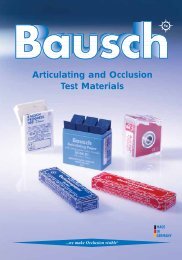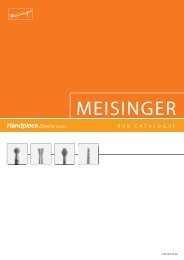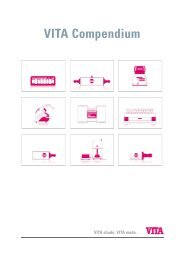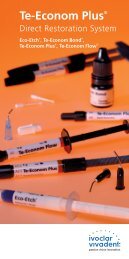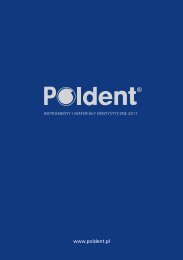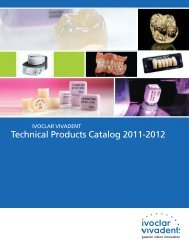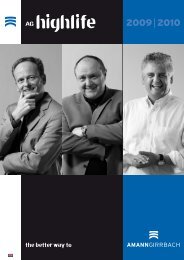BISCO DENTAL PRODUCTS CANADA - dentes.sk
BISCO DENTAL PRODUCTS CANADA - dentes.sk
BISCO DENTAL PRODUCTS CANADA - dentes.sk
You also want an ePaper? Increase the reach of your titles
YUMPU automatically turns print PDFs into web optimized ePapers that Google loves.
COMPOSITE RESTORATIVES<br />
Directed Shrinkage Technique<br />
Introduced first by Dr. Takao Fusayama, and later by Drs. Raymond Bertolotti and John Kanca III, the self-cure posterior<br />
restoration technique known as the “directed contraction shrinkage technique” has provided dentists with a reliable and<br />
efficient means of achieving sensitivity-free restorations for more than 16 years.<br />
This technique suggests that in contrast to light-cured composites, BISFIL II or 2B begins curing adjacent to the naturally<br />
warmer surfaces of the dentin. Since all composites shrink upon polymerization, the net effect of the Directed Shrinkage<br />
Technique is to direct polymerization toward the tooth, improving adaptation to the preparation. In this technique, BISFIL<br />
II or 2B needs to be overlaid with a light-cured composite such as AELITE Aesthetic Enamel.<br />
Bisfil II and 2B are 2 self-cure composites offering 2 viscosities for 2 different placement techniques – pack it or flow it,<br />
the choice is yours.<br />
The contraction forces of self-cure<br />
composites is toward the tooth, maintaining<br />
the adhesive seal of the dentin, eliminating<br />
post-operative sensitivity.<br />
1. In the following case a direct DO composite<br />
resin on the lower left second bicuspid is<br />
placed. The matrix has been placed distally.<br />
The shortened wedge is visible interproximally.<br />
2. With the BiTine-ring in place the matrix<br />
section is stabilized at the same time as the<br />
interproximal space is effectively widened for<br />
a tight contact. The shortened wedge is not<br />
interfering with the ring.<br />
3. UNI-ETCH ® withBAC is a semi-gel<br />
of phosphoric acid with disinfecting<br />
Benzalkonium Chloride used for “total-etch”<br />
bonding. The tooth is etched for 15 seconds<br />
and rinsed with water for 5 seconds. The<br />
surface is left visibly moist, for “wet bonding”.<br />
It is not dried out.<br />
4. ONE-STEP ® / ONE-STEP ® PLUS is the<br />
only single-component adhesive on the<br />
market with full compatibility to chemicallycured<br />
composites. ONE-STEP ® PLUS is the<br />
filled version. The moist tooth is generously<br />
brushed with 2 layers of ONE-STEP ® adhesive.<br />
If a Microbrush, is used, which carries less<br />
adhesive, additional coats must be applied.<br />
5. It is important to air dry correctly so the<br />
adhesive is not blown away. Start drying with<br />
the air syringe at a greater distance. Complete<br />
drying at closer distance. Total drying time is<br />
around 10 sec.<br />
6. A correctly treated surface has typical shiny<br />
“resinous” appearance. If not, additional ONE-<br />
STEP ® coats must be applied.<br />
7. Light-cure ONE-STEP ® for 10 seconds with<br />
a halogen or LED light (with calibrated power<br />
density).<br />
8. With tooth surfaces bonded, the base<br />
increment of BISFIL 2B can be prepared, either<br />
using an automix tip or by handmixing on a<br />
mixing pad. Alternatively, BISFIL II may be<br />
used if a packing technique is preferred.<br />
a<br />
b<br />
9. BISFIL 2B is placed in the deepest part of<br />
the cavity first. The cavity is filled shy of the<br />
proximal contact area. If needed, the material<br />
can be spread out using a probe. It is left to set<br />
for about 2 minutes.<br />
13. With the R.A.P.T.O.R. bur dimples are<br />
placed mesially, distally and centrally indicating<br />
fossae. Fossae are joined so that cuspal planes<br />
and fissures are created. The carbides further<br />
refine the anatomy.<br />
10. Once BISFIL 2B has hardened the rest<br />
of the cavity can be filled with a light-curing<br />
composite of choice e.g. AELITE Aesthetic<br />
Enamel.<br />
14. Following finishing, the surface can be<br />
sealed with FORTIFY or BisCover surface<br />
sealant. The occlusal surface is etched with<br />
UNI-ETCH for 15 sec. Rinsed and carefully<br />
dried with an air syringe.<br />
11. When filling the occlusal part of the cavity,<br />
the unrestricted working time of a light curing<br />
material is valuable for sculpturing.<br />
15. <strong>BISCO</strong>VER LV is a liquid polish rendering<br />
instant high gloss to the surface, in addition to<br />
sealing it.<br />
12. Finishing and polishing of the restoration<br />
is made easy and fast using the R.A.P.T.O.R. ®<br />
finishing system. With burs a. and b. occlusal<br />
anatomy is shaped. The carbides accentuate<br />
and polish the surface.<br />
16. The etched, rinsed and dried surface is<br />
painted with diluted BisCover LV and cured with<br />
a halogen light for 40 sec.<br />
Dentistry and Photography courtesy of Dr. Johan O. Hultén<br />
1-800-667-8811 / www.biscocanada.com 19



